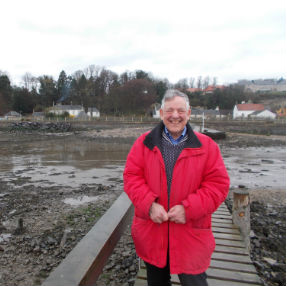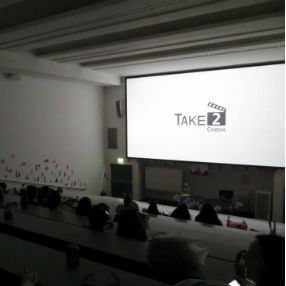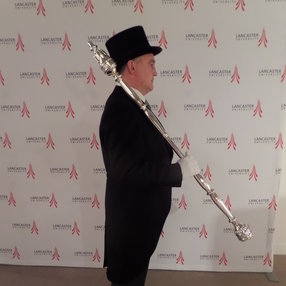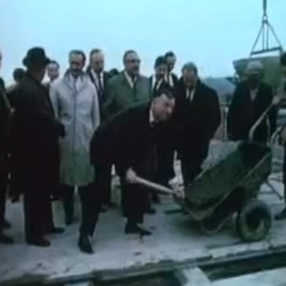Remember When
Here are some of the people and events that have made the University what it is today.
Send your memories and anecdotes (max 300 words plus a high resolution photograph) to alumni@lancaster.ac.uk.
We’ll include as many as we can.
Dr Andrew Colin: 'When I Joined Lancaster....'
Dr Andrew Colin came to Lancaster as the Director of the Computer laboratory in a time when computers had rather less power than a modern smartphone and personal computers didn't exist.
When I joined the staff of Lancaster University in 1965, it had just been founded. Bailrigg was only a building site, and Alexandra Square was a huge hole in the ground, with services being installed before it was covered over. The University was housed in temporary accommodation, in a warehouse on St. Leonardgate, in Lancaster City. Lectures were held in a nearby church.
I was formally a member of the Maths Departments, but my particular job was to look after computing. The University’s first computer was an IBM 1620 “CADET” machine, with a power that was a tiny fraction of what you would find in a mobile phone – but it still did useful work for chemists and physicists and I could teach programming with it.
We put the machine in a room on the top floor of the building. Personal computers hadn’t been invented, and the Cadet was solidly built and weighed about a ton. The lift in the building didn’t go to the top, and the delivery men spent a couple of days hauling the machine up the last flight of stairs with ropes and planks.
We used the Cadet for about a year. All the time, work at Bailrigg was progressing fast. I was particularly interested in the Computer building, designed to house the ICL1909 which was soon to be delivered. I often biked up to Bailrigg and talked to the builders. I even laid some of the bricks.
Eventually the new ICL1909 was delivered. It was literally hundreds of times faster than the Cadet and we set up a useful service for researchers and students. In those days there was no interaction and you had to prepare your programs on punched cards or paper tape. A bank of four spinning magnetic tape drives (which you might remember from early episodes of Dr. Who) completed the installation.
The operating “George II” system supplied by ICL was not suited to University use, as it forced people to wait hours or days before getting their results back from the computer, so we wrote our own which allowed a turnround of just a few minutes for short programs. It was called “June” after my secretary.
The teaching of Computer Science expanded rapidly. At first it consisted of modules within the Mathematics syllabus, but eventually it was decided to set up a separate department of Computer Studies with its own professor. I didn’t get the job, so, with great regret, I left Lancaster and took up a chair at Strathclyde University.
My most embarrassing moment? My wife and I were running a childrens’ party in the computer building. We were expecting a magician to entertain the kids, but he did not turn up on time. After an hour or so, the children were getting restive and bored. At last (it was already dark) a car drew up outside. I rushed out to it and asked the driver, “Are you the conjurer?”
“No” he replied. “I’m the Dean”.
Setting up Lancaster University Cinema
Lancaster University Cinema (LU Cinema) opened its doors in the formative years of the University and has continued to contribute to Lancaster’s student body and cultural history ever since – giving students past and present the chance to work as stewards, projectionists and organise the publicity for the cinema.
With humble origins, when films were shown on a simple 16mm projector, the Cinema has been managed entirely by students over the last fifty years and has taken significant steps forward to improving the quality of screening. In 1983, the society received a bank loan and upgraded to a 35mm projector and a larger screen, making LU Cinema the best-equipped in the North-West of England. In 1984, Dolby stereo sound was installed and new theatre lighting was added, followed by a further sound upgrade in 1988 to Dolby SR (surround). Leading the way forward for cinemas across the country, at this point LU was the fifteenth cinema in the UK to gain this standard.
LU Cinema has also had its fair share of trouble on campus, with the 2004 Film LU Film Society President Nick Gilbert saying many years ago, “The Film Society has always maintained a policy of showing controversial films that have some artistic merit, and being a non-commercial cinema, we are allowed to show films that have been banned.” As a result, over the years they have shown ‘A Clockwork Orange, ‘Crash’ and managed to cause a stir in 1982 by showing a remake of ‘The Postman Always Rings Twice’. Controversially, the latter film led to the Lancaster University Students’ Union threatening to close the cinema - as it was deemed to be offensive by the sabbatical Women’s Officer at the time – and projectionists were threatened with criminal prosecution. Ultimately, the cinema decided to separate itself from the Union and did not return until 1994.
As time has passed, LU Cinema has steadily evolved along with changes in technology and this year became Take 2 Cinema. Now a part of the University’s student media – which consists of SCAN (Student Comment And News), LA1:TV and Bailrigg FM – the Cinema have cast off their dinosaur logo and renamed themselves. Savings for students remain at the heart of the enterprise, and current President Andrew McClements stated in an interview: “The rebrand is one of many changes that are being made to the cinema… [recently] the cinema has been upgraded to digital 4K projection and 3D capabilities were added last year.”
Searching For The Origins of The University Mace
Since the very first degree ceremony for the first intake of Masters students in 1965 more than 1200 graduation ceremonies have taken place at Lancaster University and at partner organisations in the UK and overseas. At UK ceremonies, the University’s ceremonial mace is carried in front of the Presiding Officer. However who commissioned this silver mace and presented it to Lancaster University has been something of a mystery….
A current research study about degree ceremonies at Lancaster University has finally unearthed evidence that can document the origin of the Lancaster University mace.
The mace reached Lancaster University in 1965, and while the Senate minutes record an offer of a gift of silver from the University of Oxford, there was no necessary link between that reference and the mace. The search began with a close examination of the mace itself which, in addition to a Latin text that reads “EGO SUM VIA” and “VIA ET VERITAS”, (to be translated respectively as, “I AM THE WAY” and, “THE TRUTH”) there are some silver hallmarks.
These suggested that the mace was made by Garrard & Co. Ltd. in London in 1964, which coincides with the establishment of Lancaster University. Photographs of the Lancaster mace were sent to Garrard & Co. Ltd. to see if they could find out who had commissioned it. After checking their records, they came back to say that the marks were clearly theirs, but they hadn’t been able to find out who commissioned it. It seems that many of their records have been lost over the years as their business moved between different premises in London. However, just as the trail seemed to go cold, a conversation with a long serving member of staff at the University, and another with a member of The Burgon Society suggested that during the 1960s some of the newer universities had been presented with ceremonial items from the University of Oxford.
After a quick search online looking for examples of Oxford University mace a photograph was found which seemed to bear more than a passing resemblance between the Oxford University ‘stave’ and Lancaster University’s mace.
The search shifted its focus from Garrard & Co. Ltd. in London, to Oxford University, where one of the assistant archivists at The Bodleian Library confirmed the connection. What’s more they said they held a file containing more information about the origins of the Lancaster mace.
The correspondence in the file describes how, after attending the inaugural ceremonies at Lancaster University in 1964, the Vice Chancellor of Oxford University, Dr. Kenneth Wheare suggested that Oxford might present Lancaster with ‘something for use on ceremonial occasions’. His idea was approved by the Chancellor of Oxford University, who at that time was the Rt. Hon. Harold Macmillan M.P.
It was agreed that the offer of these gifts would be extended to, and limited to the recently established Universities of East Anglia, Essex, Kent, Lancaster, Stirling, Sussex, Warwick and York. Later in 1970 the New University of Ulster was also offered a similar gift.
Not surprisingly, the new universities were delighted to receive such a gift from one of the oldest and most respected universities in the world. Most of them chose a silver replica of the Oxford University stave (Faculty of Arts). The original Faculty of Arts stave was made in 1723 for Oxford University. Garrard & Co. Ltd. had a copy of the design and made a master cast for the staves destined for the new universities.
Once the new staves were made the Vice-Chancellors at the new universities were invited to pick them up. A letter from Dr. Wheare to Charles Carter, the Vice Chancellor for Lancaster University, dated 10th March, 1965 said;
“I am glad to tell you that the stave is now ready and is at present at Garrards, 112 Regent Street, London, W1. I am wondering what would be the best way to get it to you. I can arrange for Garrard’s to send it to you, or alternatively, and I hope you don’t think this an odd suggestion, perhaps the simplest thing to do would be for you to call at Garrard’s and collect it some time when you are in London. The stave is however about four feet long and might be rather inconvenient to carry, although it would of course go into a car quite easily…..” (Letter from Dr K. Wheare to Charles Carter, 10 March, 1965)
The records show that Charles Carter duly drove down to London and picked up the stave on 19th March, 1965, although there are no records to say how far he had to carry it before reaching his car!
Since 1965 the silver stave referred to as a mace has been carried into and out of all degree ceremonies at Lancaster in front of the Presiding Officer, and from time to time has been used with special permission elsewhere, including at Blackburn College and in Carlisle Cathedral.
A ‘stave’ or a ‘mace’?
During the search to find out more about the origin of the Lancaster mace there appeared to be a difference in terminology. The University of Oxford refer throughout to a ‘stave’ while the newer universities refer to a ‘mace’. There is some disagreement in higher education circles about the terms used to describe these ceremonial objects. A member of a well-established university in Scotland suggested that they can also be called ‘sceptres’. However the following quote from a book published in 1906 about Oxford Degree Ceremonies may throw some light on the difference in this particular case;
“It is to be noted that they are styled staves and not maces, the reason for the distinction being that Oxford University derives its authority from no external power and is independent.” (J. Wells, 1906)
During the last eight hundred years or so, most universities have been established under the authority of the Church, Monarch or some other established body of authority. However the three earliest European universities established in the twelfth century were not. These three universities were in Bologna (1088), Paris (c.1150) and Oxford (c.1167) and each is recorded as being established, ex consuetudine, which means they were in existence before they received any recognition from external sources of authority (Hargreaves-Mawdsley, 1963).
All three universities received papal recognition later in the form of a papal bull, (University of Bologna, 1217, University of Paris, 13th April, 1231, University of Oxford, 6thOctober 1254). This served at that particular time to bring the universities under the protection of the church.
While this explanation helpfully clarifies the distinction between stave and mace, in the case of Lancaster, the university derived its [sic] authority from an external authority, namely H.M. the Queen in her Council, in the form of an approved Charter and Statutes, and after the application of the Great Seal, making the use of the term mace appropriate for the much younger institution (M. McClintock, 2011).
With thanks to Sandra Wearden, PhD Student, Department of Educational Research, Lancaster University
References
Hargreaves-Mawdsley, W.N. (1963) A History of academical dress in Europe until the end of the 18th century, Oxford at the Clarendon Press.
McClintock, M. (2011) Shaping the Future, a history of The University of Lancaster 1961-2011, Published by The University of Lancaster.
Wells, J. (1906) the Oxford Degree Ceremony, Oxford at The Clarendon Press.
The University Under Construction
A silent video showing some of the initial construction of the University in 1965.





